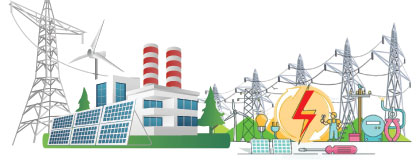Capacity charge poses risk to consumers
More power plants than demand
Zarif Mahmud : The government is increasing the production capacity compared to the demand of electricity. As a result, regular capacity charges have to be paid even if power is not purchased from installed power plants. The cost of power generation is increasing. Energy experts feel that the price hike is being passed on to consumers.
In 2016 Power System Master Plan (PSMP) estimated electricity demand in 2024 at 20,129 MW. However, it is believed that the maximum demand for electricity this year may be 17,800 megawatts.
Currently, the power generation capacity is 26,844 megawatts. That is, the country has an additional power generation capacity of nine thousand megawatts.
Apart from this, according to the Electricity Development Board data, captive power generation capacity (self-generated power in industries) and non-grid-connected renewable energy is 3,223 MW.
Khandaker Golam Moazzem, director of research at the Center for Policy Dialogue, said the government is spending more money than necessary because of the high production capacity.
“As a result, the government has to repeatedly adjust power prices to meet higher production costs.” Production costs rise because of the power capacity charge-the charge that generators pay for every hour of idle time.
In many countries around the world, the norm is to keep electricity generation capacity 20 percent higher
than peak demand, called reserve margin-which is largely unused.
The 2016 Master Plan says that by 2025, when the peak demand will be 21,903 MW, the generation capacity will be a little over 26,000 as a reserve margin of 20 percent.
But due to lack of that much demand of power, the actual reserve margin is more than 35 percent and this number will increase in the coming days.
The master plan, which was revised once in 2018, also says that it is necessary to have a reserve margin at a fixed rate to ensure uninterrupted and robust power supply. However, unplanned and aggressive capacity building may increase the reserve margin and create additional pressure on the country’s economy.
According to the master plan, intensive research is needed to determine how much reserve margin will be required to continue uninterrupted and reliable power supply to consumers.
According to the Integrated Energy and Power Masterplan, prepared in 2023 as a follow-up to the previous masterplan, there is no possibility of the reserve capacity falling even close to 20 percent before 2040.
It is said that the reserve capacity will be around 30 percent in the 2030s. CPD said in a study last week outlining the supply-demand comparison that the government is increasing capacity without considering the increase in demand for electricity.
It shows that the power generation capacity increased at a proportional rate until 2018, but later the power demand line and the production capacity line are reversed. Due to excess capacity, the government has to keep several power plants idle every day. Capacity charges have to be calculated for them from the government exchequer.
In the last financial year, PDB had to pay more than Tk 26 thousand crore as capacity payment. According to CPD’s research, PDB had to pay a loss of Tk 43,539 crore in the financial year 2022-23 due to the increase in electricity prices three times in the first quarter of last year. However, the government has given them a subsidy of Tk 39,534 crores.
According to the CPD study, there is a correlation between increasing power generation capacity and increasing government subsidies.
Golam Moazzem said, due to the increase in the cost of diesel or furnace oil in rental and quick rental power plants, PDB is incurring additional expenses. Besides, private power producers have to pay significant amount for capacity payment.
“People have no responsibility behind this cost increase. In that case, why will the government increase the price of electricity in the name of reducing the subsidy of this sector and put the burden of additional cost on the people?’ he asked. Vice President of Consumers Association of Bangladesh Professor M Shamsul Alam said that the main reasons for the increase in the cost of electricity production are faulty management, wrong policies and more capacity than required.
He said that the government has made many companies in the power sector, but none of them are in losses. All companies except PDB are making profit, government is taking profit share from them, taking dividend fund money, taking corporate tax.
On the other hand, when the government brought private power producers into the business, they did not create any competitive environment. As a result, no one knows where they have spent how much money, how much they are making, this energy expert commented.
He said that while the power demand has increased by only three percent, the government has increased the capacity by 12 percent. “It is injustice, injustice to the people,” he said.
Mohammad Hossain, director general of Power Cell, said the government also considers many abandoned or old power plants to calculate capacity.
“It is done to show the success of the government on a larger scale. But actually, the reserve capacity is more or less 20 percent, not more than that.
Rare Israeli airstrike in Beirut kills Hezbollah commander and more than a dozen others
International Desk: Israel launched a rare airstrike that killed a senior Hezbollah milita…








